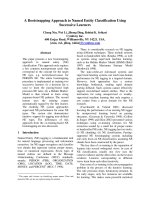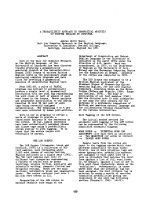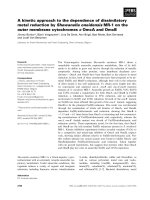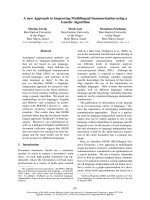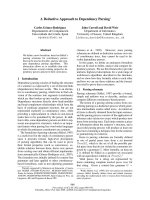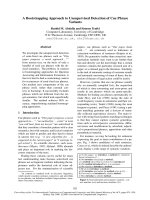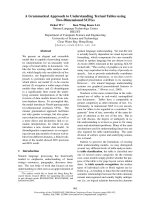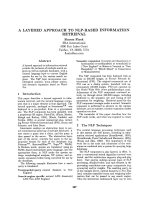Báo cáo khoa học: "A MODULAR APPROACH TO STORY GENERATION" potx
Bạn đang xem bản rút gọn của tài liệu. Xem và tải ngay bản đầy đủ của tài liệu tại đây (646.15 KB, 8 trang )
A MODULAR APPROACH TO STORY GENERATION
Lyn Pemberton
School of Cognitive and Computing Sciences
University of Sussex
Falmer~
Brighton
BN1 9QN
United Kingdom
ABSTRACT
One way of characterising texts is in terms of
the discourse structures on which they appear
to be built. Each type of text, or genre, e.g. the
sports report, the recipe, the sermon, the
proverb, will have associated with it a
characteristic organisation of units. In this
paper, a general model of the structure of one
text type, the story, is described. This model
forms the basis of a program which combines
the general story structure principles with rules
goveming a particular sub-genre, the Old
French epic, in order to generate story
summaries.
INTRODUCTION
Over the last twelve years, research in
Psychology and AI into narrative structure has
been marked by acrimonious disputes over the
right to existence of the "story grammar"
approach. The point at issue is whether it is
possible, as story grammarians suggest, to
identify structural regularities particular to
narrative texts (Mandler and Johnson, 1980;
Pemberton, 1987; Shen, 1988), or whether any
structural regularities should be interpreted
rather as world knowledge, usable in contexts
other than stories (Gamham, 1983; Wilensky,
1980; Yazdani, 1982).
The work described in this paper adopts the
story grammarian position, arguing that a
general model of story structure may be used,
in conjunction with, but separate from, a
model of the "story world", to generate stories.
Moreover, a fuller version of such an account
of story generation must draw not only on the
general story structure model and the story
world model, but also on aspects of the
audience, the author, the medium of expression
and the cultural context.
TEXT
TYPES
People are able to categorise texts into types,
according to the global conditions of
coherence which they perceive at work in
texts. Knowledge of the particular structures of
each text type is an element of the cultural
competence of the speaker/hearer, enabling
him/her to process varieties of cultural artefact
such as jokes, sermons, weather reports, sets of
instructions and so on, in appropriate ways
(Ryan, 1981).
Often, especially in "realistic" texts, it may
seem that these conditions of coherence are
reducible to the everyday concepts which we
use to analyse aspects of the real world,
especially notions such as plans, goals and
intentions. On the other hand, the fact that the
same real world events, e.g. a road accident,
or a bank robbery, may be represented in texts
of widely different types, such as a newspaper
article, a telegram message, a joke, or a
conversational anecdote, indicates that
structuring models, in addition to those
imposed by the structure of the content, are at
work in texts. Such models facilitate the
- 217-
processing of texts, creating certain
expectations when we recognise a text as an
instance of a particular genre, and providing a
set of patterns to guide the creation of new
instances.
Text types interact in complex ways with the
other categorial features of texts, such as
content, speaker type, speech situation, register
and speech act identity. Sometimes, text types
are highly constrained in this regard. For
example, conventionally a text of the "sermon"
genre is uttered in the "church service" speech
situation, in a formal register: it is normally
produced only by a priest-figure, and often
serves as a "warning" or "exhortation" speech
act. Texts of the story genre are not tightly
linked to any such characteristics: they may be
expressed by anyone, in any register, in almost
any speech situation, and, while their
illocutionary force is essentially "assertion",
their intended perlocutionary forces may be
many and varied. However, sub-genres such as
the detective story, the narrative ballad, the
traditional folk tale and so on, will impose
further constraints of their own.
A MODEL OF STORY GENERATION
As this discussion of genre theory implies,
story structure cannot be discussed in isolation
from a variety of other constraints. A theory of
story structure for the purposes of text
generation must be situated within a broader
theory of story production, which can perhaps
best be described in terms of the sorts of
knowledge which contribute to the creation of
a story. A full story generating system would
need access to many different kinds of separate
but interacting knowledge. These would
include knowledge of:
(a) story structure
Co) the audience
(c) the author
(d) the cultural context
(e) the rules of the sub-genre
Knowledge of the audience will influence what
information should be included in the text and
what can be taken as read. Characteristics of
the author may lead, for instance, to choices
which give a
particular perlocutionary
force to
the text: a moralist might insist on a fictional
wrongdoer coming to a sticky end, where a
cynic might let him/her go unpunished. The
cultural context refers to the socio-historical
setting in which the text is produced, which
restricts the particular sub-genres available:
tales of saints' lives, for instance, all the rage
in the Twelfth Century, are now out of vogue
and so virtually "untellable". The rules of the
sub-genre will place constraints not only on
the content of the text, but also on the choice
of expressive medium and on stylistic choices
within the expressive medium: verse will be
fine for a narrative ballad, inappropriate for a
detective story. It is knowledge of types (a)
and (e) which is encoded in the grammar of the
Old French epic described below.
A STORY GRAMMAR FOR THE EPIC
The study reported in (Pemberton, 1984) is an
attempt to identify a general model of story
structure, as well as the additional constraints
on the form and content of a particular sub-
genre, the mediaeval French epic. Nine poems
composed in mediaeval France, concerning the
adventures of a family of French Christian
fighters, were analysed and their narrative
structure described in terms of a grammar.
It was found necessary to distinguish between
various levels of analysis of the text. The
textual
level is that which the reader
experiences directly: in the poems in question,
a textual element might be "Guillelmes vit
Cation" (Guillaume saw Charles). The textual
level, which is not included in the study, may
be thought of as the lexicalised version of the
layer of analysis referred to as
discourse.
This
is in turn a modified version of the
story line,
where the story line is the succession of all the
events in a
story,
and discourse consists of
these same events restructured into a form
- 218 -
suitable for telling. The story line of a
detective story, for instance, would recount the
crime and its detection in chronological
sequence, while the discourse ordering might
begin instead with the discovery of the crime.
While discourse and story line differ in
structure relative to each other, they share the
same elements, which consist of propositions
formed of events and actors. A typical
discourse/storyline element might be
"saw(Guillaume, Charles)". The highest level
of analysis, the narrative model, is the abstract
form of the story line. Units at this level are as
free of content as possible, and consist of
combinations of functions and roles. The set of
functions in the grammar includes elements
such as "cause," "succeed" and "attempt",
while roles are case-like notions such as
"subject," "beneficiary" and "opponent". The
narrative model is a construct applicable to
many different types of story, whereas units of
discourse and storyline will be peculiar to the
genre in question.
NARRATIVE
Information about story structure takes the
form of a grammar, whose starting symbol is
complex stories. A complex story consists of
one or more simple stories. Two stories may
be combined using any of four links: these are
cause, where the first story causes the second;
motive, where a particular action of the first
story motivates the second; then, where all the
active elements of one story follow all the
active elements of the other, and same actor,
where there is merely sharing of one or more
actors.
The simple story is expanded into an initial
situation, an active event, and a final situation.
Semantic restrictions on the initial situation
state that it must involve two roles, subject and
object or object class, in a relation of lack,
while the final situation must consist of a
negation or restatement of the initial lack. The
active event consists of an event in which the
subject (or a surrogate) attempts to obtain the
object, or a member of the object class. Each
element is linked to the next by succession in
time, while final situation is linked to the
active event in a causal relationship.
The active event is expanded into a five-part
structure consisting of motivation, plan,
qualification, action, and resolution. The
motivation phase consists of the process
whereby the subject or surrogate subject
acquires the will to bring an end to the initial
situation by means of some action. There are
two types of motivation: general motivation
looks back to the initial situation, while
specific motivation looks forward to the action
which will end the initial situation. An
everyday example will illustrate this
distinction: a person who is hungry will have a
general motivation to end that state of hunger,
but only when confronted with the sight of,
say, a loaf of bread, will s/he acquire the
specific motivation to end the undesirable state
by an action. The stimuli which bring about
general and specific motivation are referred to
as motivating acts.
The plan phase consists of the subject's
acquisition of the knowledge needed to
perform the main act: this knowledge is
acquired via one or more informing acts.
Similarly, qualification is the process of
acquiring the power, material or physical, to
carry out the main act, via a series of
qualifying acts. The action is the subject's
attempt to obtain the object, while resolution is
the phase in which the success or failure of the
action is made clear, determining whether the
final situation is to be a negation or a
reaffirmation of the initial state. Within tiffs
scheme, recursion allows for several attempts
to be made on the same goal, or for a new goal
to be set.
The terminal elements of this grammar of the
narrative model are narrative motifs, which,
when instantiated, will make up the
chronological flow of the text. It is these
motifs which provide the answer to the
question "What happened next?" in the story.
- 219 -
However, few real-life story texts could be
described in terms of the bare minimum of
propositions generated by the grammar as
sketched so far: much more richness of detail
is required. The grammar allows for this extra
detail by permitting any element of the active
event to be supplemented by other narrative
motifs, of two types,
tied
or
free.
Tied
narrative motifs are those which expand
elements generated by the narrative model: a
qualifying act, for instance, may be expressed
in several steps, or several motivating acts may
take place. However, even the simplest
narrative text contains representations of
events which, while not deriving from the
narrative model, still describe what happened
next (cf. Shen, 1988). These are free narrative
motifs, which may illustrate character,
exemplify themes, create irony, suggest an
historical setting, and so on (cf. Barthes,
1970). Particularly important for the epic is the
opposition
motif, which serves to hinder,
jeopardise or delay some element of the active
event.
STORY LINE
The movement between the elements of the
narrative model and those of the story line may
be seen essentially as a process of
instantiation, detailing which types of actors
from the story world of the genre may fill
which roles, and which types of events may
serve which functions. For reasons of space,
the reader is referred to (Pemberton, 1984) for
details of the epic story world.
DISCOURSE
Mapping between story line and discourse
involves transformations determining which
elements derived from the narrative model
may go unexpressed in the text, and which
may be presented out of their original order.
Two of the more important deletion
transformations involve the non-expression of
high level constituents, the plan and
qualification phases. These are necessary
because few of the stories in the corpus
correspond exactly to the the problem solving
model of human behaviour reflected in the full
form of the grammar. In particular, only two of
the simple stories which make up the fifty two
stories identified in the texts include an
expression of the plan sequence: in both cases
this happens when the planned action is a ruse.
Thus fifty of the stories are without a planning
phase. Moreover, several stories omit both
planning and qualification: this happens in
stories where an actor who has provided aid to
a successful
subject
is rewarded, or where he is
otherwise presented with the object, without
having to carry out any directed action to
acquire it.
Elsewhere, it is potential redundancy which
allows the safe deletion of elements. The initial
situation, for instance, is not normally
expressed. In cause linked stories, this is
presumably because the audience may be
assumed to have heard a first story, such as
"Charles won Paris from Saladin" and be able
to infer from it that Saladin now lacks Paris. In
other examples, it is shared cultural
assumptions which make it unnecessary to
state explicitly that, for instance, where a city
is in Saracen hands, a French knight will covet
it: to say so would be stating the obvious for
the contemporary audience.
Other elements capable of deletion include the
resolution and final situation. In all these
examples, the principle at work appears to be
that of easy inferability: an element of the
canonical form may go unexpressed wherever
it is almost as easy to retrieve as one expressed
in the text (Johnson and Mandler, 1980). The
qualifying and action phases are never omitted.
The rules governing movement of elements
will not be discussed in detail here (see
Pemberton, 1984). In many stories, the order
of elements as they are presented to the reader
corresponds exactly to that of the story line,
i.e. discourse and story line ordering coincide.
Departures from the story line order are
associated with the points at which stories are
- 220 -
interwoven: an example would be when an
actor is motivated to pursue one goal while
engaged in the pursuit of another. This is a
common situation in the texts of the corpus,
where a subject often catches sight of his
future wife while he is involved in the
conquest of a city.
The GESTER Program
The GESTER program (GEnerating STories
from Epic Rules) is a first step towards
generating stories from interacting modules of
independent knowledge. The program is
written in POPLOG Prolog, using Prolog's
grammar rule facility. The program has access
to information about story structure, in the
form of a simplified version of the narrative
grammar described above, and to the possible
events and actors of the epic sub-genre, in the
form of a simplified version of the discourse
grammar and a database of objects and
attributes in the epic world. In other words, it
produces summaries from knowledge sources
(a) and (e). No special information about the
author and audience is introduced, i.e. the
program ignores modules (b) and (c), and I
assume that knowledge of the cultural context
(d) is adequately represented here by the
constraints imposed by the rules of the sub-
genre (e). Since it would be outside the scope
of the project to produce output in the
appropriate linguistic form, i.e. Old French
verse, the program produces summaries in a
makeshift canned English-like representation.
The Story Structure Rules are described at a
level of generality which makes it possible for
them to be used in the generation of stories of
any traditional genre when combined with
suitable story world rules and facts. The
highest level rules, complex_story, represent
the "root" of the parse tree generated by the
program to represent the structure of the stories
it produces. At the moment, a complex story
consists of just two simple stories. The
program generates stories by choosing one of
the complex_story rules to serve as the root
and then proceeding through the tree, making
choices as allowed by the constraints imposed
by the Story World roles, which in turn refer to
the facts stored in the Story World database,
until the terminal symbols are reached.
Recursion allows for repeated attempts at a
goal before final success or failure, and
opposition motifs are also generated.
The program uses a variety of features to
produce an acceptably coherent story. They
may usefuUy be divided into three groups:
firstly, there are story features, which are used
to determine a variety of characteristics of the
complex story; secondly, role features, which
guarantee one kind of coherence by assigning
the same roles to the same actors throughout a
story; and thirdly, transformation features,
which regulate the mapping between story line
and discourse levels. There are four story
features, Link, Resolution, Mode and Motive.
Link is the feature which describes the way in
which the two component stories of the
complex stories are joined together. Its
possible values are cause, motive, then and
same_actor, corresponding to the possibilities
uncovered in the original study. The resolution
feature simply determines whether a story will
be successfully resolved, while the mode
feature is used to distinguish stories involving
friendly interactions from those involving
hostility. The motivation feature allows for the
specification of particular types of motivating
act.
The seven role features specify relations
between actors. For instance, there might be a
story describing the attack by GuiUaume
(Subject) on the city of Saragossa (Object,
with Object category city), currently ruled by
Thibaut (Source), in which he is helped by
Charles (Auxiliary), with opposition from
Clarion (Opponent), after which Guinaume
(Beneficiary) rules the city.
The program also incorporates two
transformation features, delete and move, to
generate the story summary to the level of
discourse. Deletion is managed via the delete
- 221 -
feature, which may have values delete and
no_delete. With delete switched on, some or
all of those elements which may legally be
deleted will no longer included in the output
version. The move feature, with values move
and no_move, allows for elements of a second
story to be interwoven with those of the first,
according to the rules identified in the original
study.
The Story Structure Rules use these features to
generate complex stories to the level firstly of
narrative, then of a simplified form of
discourse.
The choice of actors and actions to appear in a
story is constrained by the rules contained in
the Story World Rules module. These
comprise, firstly, "lexicalisation rules" for the
non-terminal elements generated by the
general grammar, e.g. "try to obtain (a city)" is
to be lexicalised as "take by siege" or "take by
ruse." Similarly, motivating acts in stories
concerning the conquest of a city may be:
(a) hearsay
(b) hearing its defenders are absent
(c) presence of allied prisoners in city
(d) sight of the city
(e) loss of one's own city
(f) a taunt from the city's ruler
When a wife is the object, the subject may be
motivated by:
(a) hearsay
(b) a love letter from the woman
(c) nagging by advisors
(d) sight of the woman
(e) hearing a song about the woman
Secondly, Story World Rules detail the
restrictions on possible combinations of actors
and actions. For instance, while a Christian
knight may attempt to marry any Saracen
woman, even one who is already married, a
Saracen man may not woo a Christian woman,
married or not. Other rules specify aspects of
loyalty, inheritance, religious belief, marriage
and military practice, identified from the
analysis of the Old French corpus. Some rules
involve several inference steps. For example,
to choose an auxiliary, the program first checks
to see if any actor is flagged as being
particularly friendly towards the subject, as a
result of having helped him or having received
his help in earlier stories. If not, an auxiliary is
sought amongst members of the set of male
co-nationals of the appropriate status (e.g.
knights rather than commoners or priests),
with a family member, father or brother, being
preferred to a mere compatriot. However, if the
subject has previously displeased the potential
auxiliary, perhaps by not rewarding him for
services rendered, he will refuse to help.
Similarly, if the subject happens to be a rebel,
his family and compatriots will all refuse to
help him, and he will have to accept an actor
of the opposing nation as his ally. None of this
reasoning, of course, appears in the story
summary itself: it merely serves as its logical
underpinning.
The Story World database module contains
necessary facts about objects and relations.
There are only three types of object
represented in the database, people, cities and
deities. Facts such as the social status, marital
status, family and social relations, nationality
and gender are found here, ready to be called
on by the Story World Rules. Obviously this is
only a very small proportion of the facts which
would have to be made available to the rest of
the program if it were to produce stories
rivalling the richness of incident found in the
epic.
The program's output consists of the string of
terminal elements making up the content of the
story, together with a representation of its
parse tree. An example story is set out below.
This is a complex story in which the French
king, Charles, wins first the city of Narbonne
(S1), then a Saracen wife, Blancheflor, whom
he sees while invading the city ($2). In order
to produce this summary, the program
determines possible subject-object
combinations for the first story, choosing
- 222 -
appropriate acto~ for the supponing roles. At
various poin~ in the processing, inferences are
made about obligatory and option~ even~. For
instance, Charles, as king, has no need to ask
permission of his monarch before seaing out to
conquer the caste, as a mere knight would. In
S1, the subject and auxiliary are not near the
object as the gory begins and so must fide to
Narbonne, whereas this is unnecessary in $2,
~nce Blancheflor is ~ready in Narbonne.
Various events of $2 are influenced by even~
of SI: for instance, since Charles forged to
reward his ally, Aymeri, in S1, Aymeri is
unwiUing to help in the action of $2. In a
similar way, while Thibaut opposed Charles in
S1, he cannot do so in $2, as he is in prison.
The summary was generated with the Link
feature inganti~ed to produce a motive-linked
gory, and with both deletion and movement
options chosen. Elements of the nan~ive
which are dele~d because the delete option is
chosen have been written in by hand, for the
purposes of demonstration.
?- complex story (motive, Resolution,
Mode, Motive, move, delete,
Subject, Category, Object,
Beneficiary, Auxiliary, Source,
Opponent, Nresolution, Nmode,
Nmotive, Nsubject, Ncategory,
Nobject, Nbeneficiary, Nauxiliary,
Nsource, Nopponent, Tree,
Complex_story, []).
Charles lacked a city.
[*Charles lacked a wife.]
As a result of hearing of Narbonne
Charles wanted Narbonne.
[Then Charles planned to obtain
Narbonne for Charles.]
Then Aymeri agreed to help Charles.
Then Charles and Aymeri rode to
Narbonne.
[Then Charles was ready to try to
obtain Narbonne.]
Then, Charles attacked the walls of
Narbonne, currently controlled by
Baufumez, helped by Aymeri.
Thibaut and Clarion threw burning
pitch down on Charles and Aymeri.
Charles and Aymeri retreated.
Then, Charles attacked the walls of
Narbonne, currently controlled by
Baufumez, helped by Aymeri.
Thibaut and Clarion threw stones down
on Charles and Aymeri.
Charles and Aymeri broke into
Narbonne.
*As a result of seeing Blancheflor
Charles wanted Blancheflor.
Charles succeeded in getting Narbonne.
Charles praised God. Charles forgot to
reward Aymeri. Charles threw Thibaut
into prison.
[Then as a result of getting Narbonne
Charles no longer lacked a city.]
Then Charles planned to obtain
Blancheflor for Charles.
Then Aymeri refused to help Charles
because he was not rewarded.
Then Bertrand agreed to help Charles.
[Charles was now ready to try to
obtain Blancheflor.]
Charles abducted Blancheflor,
currently controlled by Thibaut helped
by Bertrand.
Because Thibaut was in prison he did
not oppose Charles and Bertrand.
Clarion opposed Charles and Bertrand
in getting Blancheflor.
Charles succeeded in getting
Blancheflor.
Charles praised God.
Charles rewarded Bertrand.
[Then as a result of getting
Blancheflor Charles no longer lacked a
wife.]
The following not~ions are added for
clarification:
* = moved element
[ ] = de~ted element
- 223 -
FUTURE EXTENSIONS
The work described here represents a first step
in implementing a model of story generation.
The program now needs to be extended in a
number of directions. Firstly, each of the
modules must be enriched to enable greater
detail, greater variety of incident, and more
complexity of structure. The inclusion of a
more complex mapping between role and
actor, to allow for the distribution among
several actors of a single role, will be a first
step here. Secondly, the story structure rules
will be applied to a representation of a
different story world, possibly that of the fairy
tale or the romantic short story, in order to test
the independence of the modules. A further,
more ambitious extension, would be to attempt
to incorporate a mapping from the level of
discourse, to the textual level: work by Ashby
(1976) and Heinemann (1973) indicates such a
mapping to be achievable for at least a subset
of discourse motifs.
ACKNOWLEDGEMENTS
My thanks to Aaron Sloman and James
Goodlet for comments on an earlier version of
this paper.
REFERENCES
Ashby, Genette. 1976. A Generative Grammar
of the Formulaic Language in the Single
Combat in the
Chanson de Roland. PhD
Dissertation: University of Columbia.
Barthes, Roland. 1970.
S/Z.
Paris: Seuil.
van Dijk, Teun A. 1972.
Some Aspects of Text
Grammars. The
Hague: Mouton.
1980.
Macrostructures : An
Interdisciplinary Study of Global
Structures in Discourse, Interpretation
and Cognition.
New York: Lawrence
Erlbaum.
Gamham, Alan. 1983. What's wrong with
story grammars.
Cognition,
15: 145-54.
Heinemann, Edward A. 1973. Composition
stylisee et technique litteraire dans la
Chanson de Roland.
Romania,
94: 1-27.
Johnson, Nancy S. and Jean M. Mandler.
1980. A Tale of Two Structures:
underlying and surface forms in stories.
Poetics,
9: 51-86.
Mandler, Jean M and Nancy S. Johnson. 1980.
On Throwing Out the Baby with the
Bathwater: A Reply to Black and
Wilensky's Evaluation of Story
Grammars.
Cognitive Science,
4: 305-
312.
Mann, William. 1984. Discourse Structures for
Text Generation. COLING-84: 367-375.
Pemberton, Lyn. 1984.
Story Structure: A
Narrative Grammar of Nine Chansons de
Geste of the Guillaume d'Orange Cycle.
PhD dissertation: University of Toronto.
1987.
A Story Grammar for the Old
French Epic.
MSc dissertation:
University of Sussex.
Propp, Vladimir. 1928, 1968.
Morphology of
the Folktale.
Austin, Texas: University
of Texas Press.
Rumelhart, David E. 1975. Notes on a schema
for stories. In D.G. Bobrow and A.M.
Collins, eds,
Representation and
Understanding.
New York: Academic
Press.
Ryan, Marie-Laure. 1981. On the Why, What
and How of Generic Taxonomy.
Poetics,
10: 109-126.
Shen, Yeshayahu. 1988. Schema Theory and
the Processing of Narrative Texts: the
X-bar Story Grammar and the notion of
Discourse Topic.
Journal of Pragmatics,
12: 639-676.
Wilensky, Robert. 1983. Story grammars
versus story points.
Behavioral and
Brain Sciences,
6: 579-623.
Yazdani, Masoud. 1982. How to write a story.
ECAI-82 :
259-60.
- 224-
